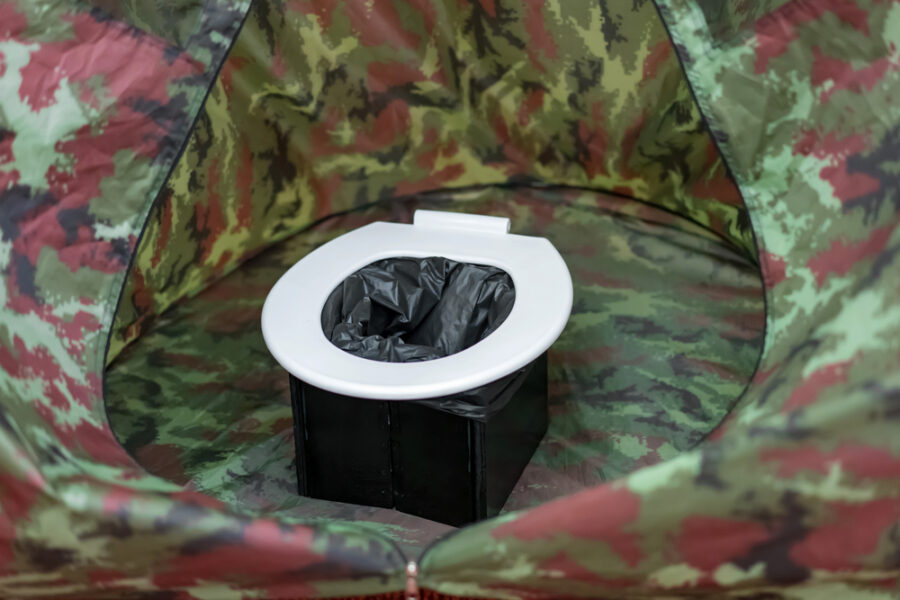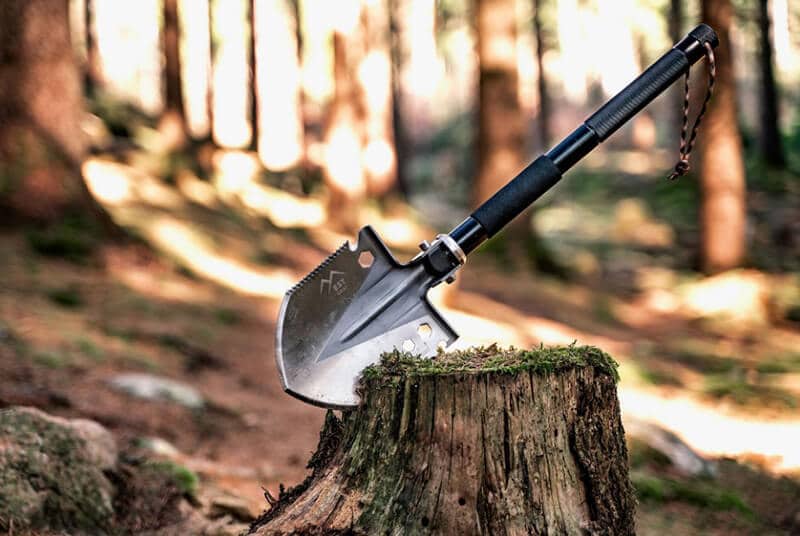Nervous about pooping in the woods during your next outdoor adventure?
You’re in the right place.
When nature calls during your camping trip, you best be prepared. That’s because, at some point during your adventures, you will have to use the loo. But, unlike at home where you can simply walk over to the bathroom to do your thing, pooping in the woods is a bit more of a process.
The good news is that we’re here to help.
We know how nerve-wracking it can be to go number 2 for the first time during a camping trip. So, we’ve created this resource to help you learn more about how to go to the bathroom while outside.
Coming up, we’ll discuss some of the most important things you need to know when pooping in the woods. That way, you can focus less on your bathroom habits and more on making the most of your time outside.
Page Contents
Why is proper disposal so important?

We know what you’re thinking – “If animals can just drop scat all over the forest floor, why should I have to do things any differently?”
While we do understand how this can be seen as a bit of an odd double standard, there are a few reasons why properly disposing of human waste is important.
According to Leave No Trace (LNT), an outdoor ethics organization that promotes the sustainable use of the outdoors, there are 4 reasons why you ought to properly dispose of human waste.
These include :
- Avoiding water pollution. Unburied or improperly disposed of human waste can get swept up by rainwater runoff and carried into a river, lake, or another water source. Yikes!
- Stopping the spread of diseases. There are a number of human diseases that can be spread through fecal matter, such as cholera, giardiasis, viral meningitis, and hepatitis A. So, proper waste disposal is key to preventing these diseases.
- Maximizing decomposition rates. Human waste will eventually decompose. But, it will decompose faster when buried properly.
- Minimizing unsightly waste. Finally, no one likes to stumble upon a pile of human waste on the trail. Disposing of human fecal matter properly can make the outdoors a better place for all to enjoy.
What are the things to prepare?

As we’ve mentioned, pooping in the woods requires a bit more foresight and planning than going to the loo at home. Indeed, without a porcelain convenience to run to whenever the urge strikes, you’ll need to come prepared with your own supplies to do the job properly.
So, whether you’re backpacking in Shenandoah or car camping in Yellowstone, here are some key toilet-related essentials you ought to bring with you while camping :
- Soap and water. First things first, no one should ever go to the bathroom outside without soap and water. While it might seem easier to use hand sanitizer, washing your hands with soap and water is more effective at stopping diseases than hand sanitizer. Oh, and you may also want a small towel for drying off your hands after washing them.
- Shovel. If burying your poop is the most environmentally friendly option in your chosen camping location, you’ll need a shovel or a trowel to do the job.
- Waste disposal bags. In some very popular outdoor destinations, such as Mount Rainier, local land managers require that you pack out all human waste. If so, you’ll need to get some human waste disposal bags (called wag bags) for your trip.
- Toilet paper. If you’d rather use regular toilet paper over natural wiping materials, you’ll want to bring a small roll with you on your travels.
- Small trash bag. While burying human waste is usually okay, burying toilet paper and other trash generally isn’t. So, bring a small trash bag for packing out any toilet paper on your trip.
- Camp toilet. If you’re car camping in a place like Death Valley National Park, you may find it easier to bring your own camp toilet instead of burying your waste.
- Bear spray. When camping in locations where bears are abundant, you’ll likely have bear spray in your gear list. In these situations, you should also carry bear spray with you when you go to the toilet.
How to find the ideal spot?

Once you have the right gear for the job, it’s time to find the ideal spot to do your business in the woods. If you’re planning on burying your waste, here are a few key things to keep in mind.
Walk at least 200 feet from water
At an absolute minimum, your toilet location should be at least 200 feet (60 m) from any body of water. You can measure out 200 feet by walking approximately 70 adult-sized paces from a water source.
As we’ve mentioned, human waste can contaminate water sources. So, Leave No Trace and most local regulations require that you bury all human waste at least 200 feet from the nearest body of water.
Get away from the trail
In addition to keeping your distance from bodies of water, you’ll want to look for a toilet location that’s far away from the trail or your campsite.
Why?
Well, in high-use places like Yosemite National Park, you don’t want someone to accidentally stumble across you while you’re doing your business.
Also, the closer you are to the trail or your campsite, the more likely it is that someone else will want to use your toilet area in the future. As you can imagine, accidentally digging up someone else’s human waste is, well, not fun.
Look for privacy
Depending on where you’re camping, you may or may not be able to find a good, private place to do your business.
In forested terrains, such as what you’d find in Olympic National Park, you can often easily find privacy among the trees.
However, in alpine areas, like Glacier National Park, or in deserts like Death Valley, privacy can be hard to come by. When there aren’t any good trees to hide behind, you can sometimes find a large boulder to serve as a privacy shield.
If not, walk as far away from your campsite or the trail as possible to avoid any potential encounters with other campers.
What are the common pooping positions?

Unlike at home, where you can simply sit down on the toilet, finding the right position for popping in the woods is a bit more complicated. Thankfully, there are plenty of great positions to use while doing your business in the backcountry.
Here are a few to try out on your next trip.
The squat
A time-honored classic, simply squatting over your cathole or waste disposal bag is often the easiest way to go to the loo. If necessary, you can often hold onto a tree or rock to stabilize yourself in the process.
The tree hug
This position is a variation of the squat, but with more emphasis on hanging onto a tree for support. To do so, you’ll dig a hole near a large tree, grab the tree trunk and lean back to suspend yourself over the hole.
Oftentimes, this position works well if you’re on a slope as you can use the tree to stabilize yourself throughout the process. Just remember to hold on tight to the tree to avoid any mishaps!
The log squat
If you come across a nice downed log during your travels, you can often use that as a makeshift bench while you answer nature’s call. Simply dig your hole behind the log, sit on the log so that your rear end hangs off of it, and do your thing.
The break dancer
In situations where you’re not comfortable squatting but you don’t have a tree to hang off of, the break dancer is a sure bet.
With this position, you’ll position yourself over your hole, just like you would if you were squatting. But, instead of simply squatting, you’ll place one hand behind you on the ground to support yourself while you do your thing. Doing so will help suspend you over your cathole without the need to do a full-on squat.
How do I dispose my poop?

At this point, you’re well aware that proper disposal is important when dealing with human waste. But, what waste disposal methods are actually available to you?
Here are 4 potential options to consider :
- Cat hole. By and large, digging a cat hole is the most common way to dispose of human waste in the backcountry. A cat hole is simply a small 6” (15 cm) deep hole that you can use to bury your waste.
- Latrines. Latrines are sort of like catholes, but they’re designed for multiple people to use over the course of a few days. However, they’re not usually ideal due to the smell and slow decomposition rate of all that waste.
- Outhouse. If your campsite has an outhouse available, it’s usually the best place to do your business.
- Wag bag. In situations where you’re required to pack out your waste, such as while rafting in Canyonlands National Park, you will need to use wag bags (waste disposal bags). Most land managers will actually provide these if they’re required, so check in at local ranger stations for more advice.
Gaby Pilson
Gaby is a professional mountain guide with a master’s degree in outdoor education. She works primarily in the polar regions as an expedition guide, though she can be found hiking, climbing, skiing, sailing, or paddling in some of the world’s most amazing places when not at work.


